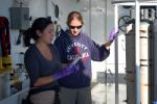The team of researchers created genetic sequences never before seen in nature, and the scientists showed that they can produce substances that sustain life in cells almost as readily as proteins produced by nature's own toolkit.
"What we have here are molecular machines that function quite well within a living organism even though they were designed from scratch and expressed from artificial genes," said Michael Hecht, a professor of chemistry at Princeton, who led the research. "This tells us that the molecular parts kit for life need not be limited to parts -- genes and proteins -- that already exist in nature."
The work, Hecht said, represents a significant advance in synthetic biology, an emerging area of research in which scientists work to design and fabricate biological components and systems that do not already exist in the natural world. One of the field's goals is to develop an entirely artificial genome composed of unique patterns of chemicals.
"Our work suggests," Hecht said, "that the construction of artificial genomes capable of sustaining cell life may be within reach."
Nearly all previous work in synthetic biology has focused on reorganizing parts drawn from natural organisms. In contrast, Hecht said, the results described by the team show that biological functions can be provided by macromolecules that were not borrowed from nature, but designed in the laboratory.
Although scientists have shown previously that proteins can be designed to fold and, in some cases, catalyze reactions, the Princeton team's work represents a new frontier in creating these synthetic proteins.
The research, which Hecht conducted with three former Princeton students and a former postdoctoral fellow, is described in a report published online Jan. 4 in the journal Public Library of Science ONE.
Hecht and the students in his lab study the relationship between biological processes on the molecular scale and processes at work on a larger magnitude. For example, he is studying how the errant folding of proteins in the brain can lead to Alzheimer's disease, and is involved in a search for compounds to thwart that process. In work that relates to the new paper, Hecht and his students also are interested in learning what processes drive the routine folding of proteins on a basic level -- as proteins need to fold in order to function -- and why certain key sequences have evolved to be central to existence. Proteins are the workhorses of organisms, produced from instructions encoded into cellular DNA. The identity of any given protein is dictated by a unique sequence of 20 chemicals known as amino acids. If the different amino acids can be viewed as letters of an alphabet, each protein sequence constitutes its own unique "sentence."
And, if a protein is 100 amino acids long (most proteins are even longer), there are an astronomically large number of possibilities of different protein sequences, Hecht said. At the heart of his team's research was to question how there are only about 100,000 different proteins produced in the human body, when there is a potential for so many more. They wondered, are these particular proteins somehow special? Or might others work equally well, even though evolution has not yet had a chance to sample them?
Hecht and his research group set about to create artificial proteins encoded by genetic sequences not seen in nature. They produced about 1 million amino acid sequences that were designed to fold into stable three-dimensional structures.
"What I believe is most intriguing about our work is that the information encoded in these artificial genes is completely novel -- it does not come from, nor is it significantly related to, information encoded by natural genes, and yet the end result is a living, functional microbe," said Michael Fisher, a co-author of the paper who earned his Ph.D. at Princeton in 2010 and is now a postdoctoral fellow at the University of California-Berkeley. "It is perhaps analogous to taking a sentence, coming up with brand new words, testing if any of our new words can take the place of any of the original words in the sentence, and finding that in some cases, the sentence retains virtually the same meaning while incorporating brand new words."
Once the team had created this new library of artificial proteins, they inserted those proteins into various mutant strains of bacteria in which certain natural genes previously had been deleted. The deleted natural genes are required for survival under a given set of conditions, including a limited food supply. Under these harsh conditions, the mutant strains of bacteria died -- unless they acquired a life-sustaining novel protein from Hecht's collection. This was significant because formation of a bacterial colony under these selective conditions could occur only if a protein in the collection had the capacity to sustain the growth of living cells.
In a series of experiments exploring the role of differing proteins, the scientists showed that several different strains of bacteria that should have died were rescued by novel proteins designed in the laboratory. "These artificial proteins bear no relation to any known biological sequences, yet they sustained life," Hecht said.
Added Kara McKinley, also a co-author and a 2010 Princeton graduate who is now a Ph.D. student at the Massachusetts Institute of Technology: "This is an exciting result, because it shows that unnatural proteins can sustain a natural system, and that such proteins can be found at relatively high frequency in a library designed only for structure."
###
In addition to Hecht, Fisher and McKinley, other authors on the paper include Luke Bradley, a former postdoctoral fellow in Hecht's lab who is now an assistant professor at the University of Kentucky, and Sara Viola, a 2008 Princeton graduate who is now a medical student at Columbia University.
The research was funded by the National Science Foundation.
Title: "De Novo Designed Proteins from a Library of Artificial Sequences Function in Escherichia Coli and Enable Cell Growth"
Journal: Public Library of Science ONE
Link to paper: http://www.plosone.org/article/info%3Adoi%2F10.1371%2Fjournal.pone.0015364
END

